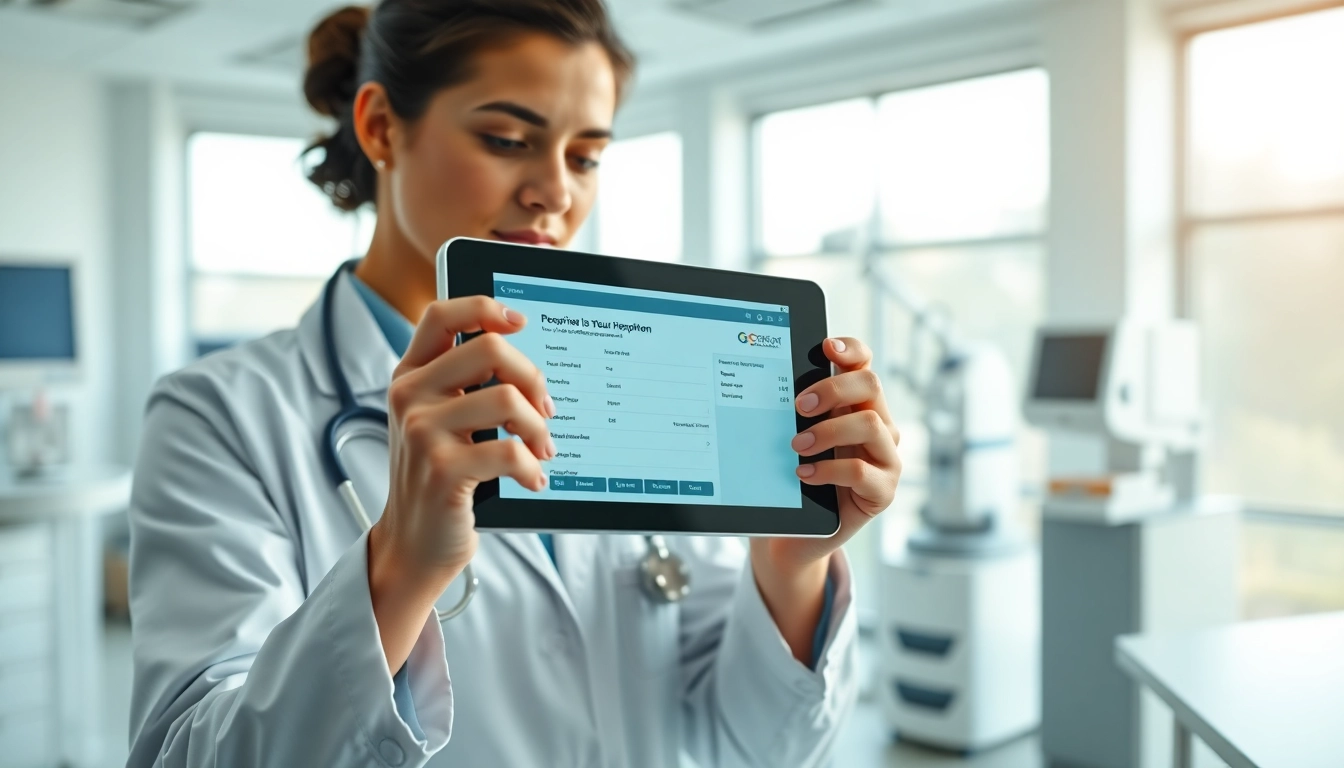Understanding the Importance of Integrating ePrescription Apps
The integration of ePrescription apps into healthcare systems is a transformative step towards enhancing patient care, optimizing workflow processes, and ensuring accurate medication management. As the healthcare industry increasingly adopts digital solutions, the urgency for effective solutions becomes apparent. This article explores the significance of integrating ePrescription apps, their benefits, challenges faced by healthcare providers, best practices, implementation steps, performance evaluation, and future trends in this evolving landscape. By understanding these aspects, healthcare stakeholders can navigate the complexities of integrating eprescription apps into their practice with greater success.
What are ePrescription Apps?
ePrescription apps are digital platforms that allow healthcare providers to electronically send prescriptions to pharmacies, rather than relying on traditional handwritten prescriptions. These apps streamline the prescribing process, improve accuracy, and enhance communication between providers and pharmacists. ePrescription apps can be standalone solutions or integrated into broader Electronic Health Record (EHR) systems, enabling seamless access to patient medication histories, allergies, and other relevant health information. The increasing adoption of ePrescription technology has resulted from advancements in healthcare interoperability and a growing demand for patient safety and efficiency in prescribing practices.
Key Benefits of Integration
The integration of ePrescription apps into existing healthcare systems offers several compelling benefits:
- Improved Patient Safety: By reducing errors associated with handwritten prescriptions, ePrescribing minimizes the chances of misinterpretation, ensuring that patients receive the correct medications.
- Enhanced Efficiency: ePrescription apps streamline the prescribing process, allowing providers to write, send, and manage prescriptions more quickly and easily. This ultimately leads to reduced waiting times for patients and improved workflow for healthcare staff.
- Better Medication Management: Integration facilitates real-time access to patients’ medication records, enabling healthcare providers to make informed decisions, manage medication interactions, and review patient adherence.
- Increased Patient Engagement: Many ePrescription apps offer patient-facing features that empower individuals to manage their prescriptions better, receive reminders, and engage with their healthcare providers about their treatment plans.
- Cost Savings: By reducing medication errors and improving adherence, ePrescription can lead to significant cost savings for both patients and healthcare systems, as well as lower healthcare expenditures.
- Streamlined Pharmacy Communication: Integration ensures that pharmacists receive prescriptions promptly and accurately, which improves collaboration between healthcare providers and pharmacies.
Challenges Faced by Healthcare Providers
While the advantages of ePrescription apps are clear, various challenges exist that healthcare providers must navigate during integration:
- Technical Barriers: Integrating ePrescription solutions often requires upgrading existing IT infrastructure, which can be costly and time-consuming for healthcare organizations.
- Change Resistance: Staff and providers may resist transitioning to digital solutions due to familiarity with traditional methods. This resistance can lead to improper implementation and underutilization of ePrescription apps.
- Interoperability Issues: Ensuring ePrescription apps work seamlessly with other health IT systems, such as EHRs and practice management software, can pose significant challenges, particularly when dealing with disparate systems.
- Regulatory Compliance: Adhering to regulations and standards concerning patient data privacy and security is vital. Health organizations must remain compliant while integrating new technologies.
- Training Needs: Proper training is essential to ensure that staff and providers can use ePrescription apps effectively. Failure to provide adequate training can lead to errors and inefficiencies.
Best Practices for Successful Integration of ePrescription Apps
Choosing the Right ePrescription Solution
Selecting the correct ePrescription solution is a critical first step in ensuring successful integration. Healthcare organizations should consider the following aspects during the selection process:
- Compatibility: Ensure that the ePrescription app aligns well with existing systems and can interface with EHRs and pharmacy management systems without complications.
- User-Friendly Interface: An intuitive interface is crucial for user adoption—staff should be able to navigate the app with ease, minimizing the learning curve.
- Vendor Support: Evaluate the level of training, technical support, and resources offered by the vendor, as continuous support is essential for successful implementation.
- Scalability: The solution should be scalable, accommodating future growth and additional functionalities as the healthcare landscape evolves.
- Security Features: Prioritize solutions with robust security measures to ensure patient data privacy and compliance with regulations.
Engaging Stakeholders in the Integration Process
Successful integration of ePrescription apps requires collaboration and buy-in from all stakeholders, including providers, pharmacists, IT teams, and administrative staff. Engaging these stakeholders can be achieved through:
- Collaborative Discussions: Involve all relevant parties in discussions about the benefits and functionalities of ePrescription apps to foster a sense of ownership in the integration process.
- Regular Updates: Keep stakeholders informed about implementation timelines, training sessions, and feedback opportunities to facilitate transparency and encourage participation.
- Feedback Mechanisms: Create channels for stakeholders to provide feedback and voice concerns during the integration process to ensure any issues are promptly addressed.
- Highlighting Success Stories: Share examples of organizations that have successfully integrated ePrescription apps to demonstrate value and promote enthusiasm among staff.
Training Staff on New Systems
Proper training is vital for successful integration. Organizations should implement structured training programs involving:
- Comprehensive Workshops: Conduct workshops that cover app functionalities, common issues, and troubleshooting steps. These should be tailored to various user groups, including providers and administrative staff.
- Peer Training: Facilitate peer-led training sessions where early adopters can share their experiences and tips with colleagues.
- Continuous Learning Opportunities: Offer ongoing training resources, such as webinars and online tutorials, to ensure staff remain up-to-date with app updates and best practices.
- Assessment Surveys: Assess staff knowledge pre-and post-training to identify gaps and adjust training materials as needed.
Implementation Steps for Integrating ePrescription Apps
Initial Assessment of Current Systems
The first step toward integrating ePrescription apps involves conducting a thorough assessment of the current IT landscape. Organizations should evaluate:
- Existing Software and Hardware: Identify the current EHR system, its capabilities, and the hardware needed to support the ePrescription integration.
- Workflow Analysis: Analyze existing workflows to identify pain points that the ePrescription solution can address, ensuring that integration aligns with clinical practices.
- Data Accessibility: Evaluate the availability of patient data needed for seamless integration, including medication histories and allergy information.
- Staff Readiness: Assess staff familiarity with technology, noting any areas where additional training may be necessary.
Creating a Detailed Implementation Plan
Once the assessment is complete, organizations should develop a comprehensive implementation plan, which includes:
- Timeline Development: Establish clear timelines for each phase of integration, including milestones for training, testing, and full launch.
- Budget Considerations: Estimate costs for software licenses, hardware upgrades, training sessions, and ongoing support.
- Risk Management Strategies: Identify potential challenges and develop contingency plans to mitigate risks during implementation.
- Resource Allocation: Designate resources, including team leads and support staff, to manage the integration process effectively.
Testing and Quality Assurance Procedures
Testing is a crucial phase in the integration of ePrescription apps. Organizations should implement the following quality assurance procedures:
- Functional Testing: Verify that all app functionalities work as intended across different user scenarios and devices.
- Data Migration Testing: Ensure that data transferred from existing systems to the ePrescription app is accurate and complete.
- User Acceptance Testing: Involve end-users in testing to identify usability issues and ensure they can navigate the app comfortably.
- Feedback Loop: Establish a system for collecting feedback from users during the testing phase to make necessary adjustments before the full rollout.
Evaluating Performance Metrics After Integration
Monitoring User Engagement and Efficiency
Post-integration evaluation is essential for determining the effectiveness of ePrescription apps. Healthcare organizations should monitor key performance metrics related to:
- Adoption Rates: Track how many providers use the ePrescription app and how frequently they rely on it for prescribing.
- Prescription Processing Time: Measure the time taken to complete a prescription from initiation to delivery at the pharmacy.
- User Satisfaction: Regularly survey users to gauge satisfaction levels and identify areas for improvement.
- Error Rates: Monitor the frequency of prescription errors before and after integration to quantify improvements.
Assessing Patient Outcomes
In addition to user engagement, it is crucial to evaluate the impact of ePrescription apps on patient outcomes, which can be assessed through:
- Medication Adherence Rates: Analyze how well patients adhere to prescribed medication regimens before and after ePrescription implementation.
- Patient Satisfaction Surveys: Collect patient feedback regarding their experiences with prescription fulfillment and the ease of managing their medications.
- Health Outcomes Tracking: Monitor clinical outcomes related to chronic disease management and the effectiveness of treatments linked to ePrescription data.
- Cost Reduction Analysis: Evaluate changes in healthcare costs related to medication overuse, emergency room visits, and hospital readmissions.
Continuous Feedback and Improvement Cycles
To ensure sustained success, healthcare organizations should establish cycles of continuous feedback and improvement. Strategies include:
- Regular Review Meetings: Schedule meetings with staff and stakeholders to discuss feedback, challenges, and successes related to the ePrescription app.
- Iterative Improvement: Be open to making iterative changes based on feedback, evolving workflows, and emerging technologies.
- Engagement with Users: Foster ongoing engagement through forums, focus groups, or suggestion boxes to maintain an adaptive and responsive environment.
- Performance Benchmarking: Compare performance metrics against established benchmarks or other organizations to identify areas for advancement.
Future Trends in ePrescription App Integration
Technology Advancements on the Horizon
The future of ePrescription apps is poised for significant advancements driven by technological innovation. Key trends include:
- Artificial Intelligence: AI will play a pivotal role in ePrescription apps, enabling predictive analytics for medication management and personalized treatment plans.
- Telemedicine Integration: As telemedicine becomes more prevalent, ePrescription apps will increasingly incorporate virtual consultations to streamline the prescribing process.
- Blockchain Technology: Blockchain may enhance security and interoperability in ePrescribing by allowing secure data sharing across platforms while preserving patient privacy.
- Mobile Health Solutions: The rise of mobile health apps will lead to more design innovations that foster patient engagement, making it easier to manage prescriptions directly from mobile devices.
Patient-Centric Approaches in Future Applications
The evolution of ePrescription apps will increasingly prioritize patient-centric features, such as:
- Personalized Messaging: Enhanced communication tools will facilitate more personalized engagement between providers and patients, ensuring patients are well-informed about their medications.
- Medication Tracker Features: Future apps may include advanced tracking systems to help patients manage their medication schedules and monitor adherence levels.
- Integrated Health Condition Management: ePrescription apps will likely integrate features for chronic disease management, allowing providers to monitor patients’ health outcomes and adjust prescriptions accordingly.
- Patient Education Modules: Educational resources and tools within ePrescription apps will empower patients to understand their conditions and treatment options better.
Adapting to Regulatory Changes and Compliance
As regulatory frameworks evolve, ePrescription apps must adapt to remain compliant. This includes:
- Staying Informed: Organizations should proactively keep abreast of regulatory changes affecting ePrescribing and healthcare data management.
- Implementing Compliance Measures: Regular audits and assessments should ensure that ePrescription apps remain compliant with HIPAA and other relevant regulations regarding patient data.
- Data Protection Policies: Enhancing data protection policies and security practices will be vital for maintaining patient trust and safeguarding sensitive information.
- Collaborative Efforts: Engaging with industry associations and regulatory bodies can provide insights into best practices and compliance requirements as they evolve.



